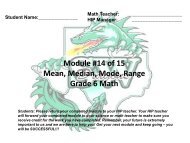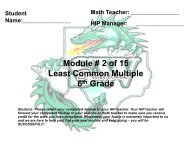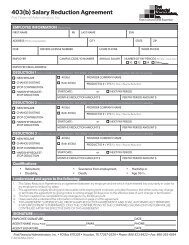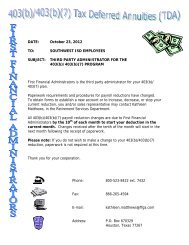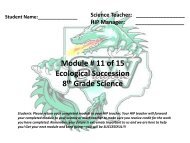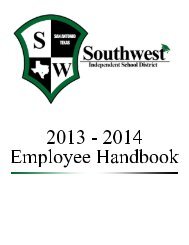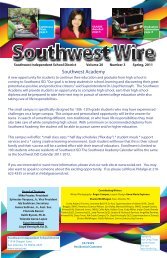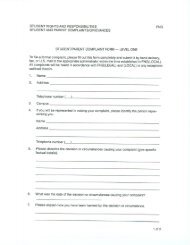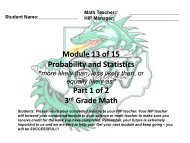Dr. Dragonosky's Mad Science Lab Presents âEcosystemsâ Module 8
Dr. Dragonosky's Mad Science Lab Presents âEcosystemsâ Module 8
Dr. Dragonosky's Mad Science Lab Presents âEcosystemsâ Module 8
You also want an ePaper? Increase the reach of your titles
YUMPU automatically turns print PDFs into web optimized ePapers that Google loves.
Student Name:_______________<br />
<strong>Science</strong> Teacher: ________________<br />
HIP Manager: ________________<br />
<strong>Module</strong> 10 of 15<br />
Ecosystems<br />
Grade 8<br />
Students: Please return your completed module to your HIP teacher. Your HIP teacher will forward<br />
your completed module to your science or math teacher to make sure you receive credit for the work<br />
you have completed. Remember, your future is extremely important to us and we are here to help<br />
you! Get your next module and keep going – you will be SUCCESSFUL!!!
Organism<br />
• An organism is any single living thing on Earth<br />
• Examples: plant, insect, or animal
Population<br />
• More than one living thing of the same kind<br />
living in an area<br />
• Example: A group of the same kind of tree
Community<br />
• More than one population of living things in<br />
one area<br />
• Example: grass, flowers, and tigers
Ecosystem<br />
• An ecosystem is the<br />
interaction between all<br />
the living and nonliving<br />
things in one area<br />
• Can you name all of the<br />
living things in this<br />
picture?<br />
• What do you think<br />
nonliving things might<br />
be?
Biosphere<br />
• The biosphere includes everything on the<br />
earth, including all of the living and non-living<br />
things.
Organization of an<br />
Ecosystem<br />
1<br />
Organism<br />
5<br />
Biosphere<br />
2<br />
Population<br />
4<br />
Ecosystem<br />
3<br />
Community
Practice<br />
• Determine the organization of the ecosystem<br />
by correctly labeling the pictures
Biotic<br />
• The term biotic refers to things that are living<br />
• Examples: plants, insects, and animals
Abiotic<br />
• The term abiotic refers to all the nonliving<br />
things in the environment<br />
• Examples: air, sunlight, water, rocks
Practice<br />
• Circle the pictures that show biotic factors. Put<br />
a square around the pictures that show abiotic<br />
factors.
The Sun<br />
• All processes on earth happen because of the<br />
sun.<br />
• What makes a plant grow?<br />
• _____________________________________
Photosynthesis<br />
• Photosynthesis is the process by which plants<br />
use the sun’s energy to make their own food.<br />
• The reactants in the equation for<br />
photosynthesis are Carbon dioxide and water.<br />
– CO 2 + H 2 O<br />
• The products in the equation are glucose and<br />
Oxygen.<br />
– C 6 H 12 O 6 + O 2
Formula for<br />
Photosynthesis<br />
CO 2 + H 2 O C 6 H 12 O 6 + O 2<br />
Energy from the sun drives the process of<br />
photosynthesis for plants, which gives<br />
energy to all the other organisms in a food<br />
chain.
Food Chain<br />
• A food chain shows the transfer of energy<br />
from one organism to another. All of the<br />
energy on Earth first comes from the Sun.<br />
• Example: The Sun gives energy to grass and<br />
then the energy is passed on to grasshoppers<br />
when they eat the grass.
What Does a Food Chain<br />
Show?<br />
The flow of energy!
Producers and Consumers<br />
1. The sun gives energy to Earth.<br />
2. Producers are living things that get their energy directly from<br />
the sun and make their own “food” (plants).<br />
3. Producers give energy to organisms that eat plants, or<br />
herbivores. Herbivores are primary consumers.<br />
4. Herbivores give energy to organisms that eat both plants<br />
and animals, or omnivores. Omnivores are secondary<br />
consumers.<br />
5. Omnivores give energy to organisms that eat only meat, or<br />
carnivores. Carnivores are tertiary consumers.
Order of the Flow of<br />
Energy<br />
5<br />
Tertiary Consumers<br />
(Carnivores)<br />
1<br />
4<br />
Secondary Consumers<br />
(Carnivores/Omnivores)<br />
3<br />
Primary Consumers<br />
(Herbivores)<br />
2<br />
Producers (Plants)
Practice<br />
• Earth gets energy from the _______________.<br />
• Organisms that get their energy directly from<br />
the sun are called______________.<br />
• Herbivores are _____________consumers.<br />
• Omnivores are _____________ consumers.<br />
• Carnivores are _____________ consumers.
Food Web<br />
• A food web is the interaction between two or<br />
more food chains in an ecosystem.
What is the role of the Orca in this food chain?<br />
a. Producer<br />
b. Primary Consumer<br />
c. Secondary Consumer<br />
d. Tertiary Consumer
Congratulations!!!<br />
Job well done, and we will see you again<br />
in<br />
“<strong>Dr</strong>. <strong>Dr</strong>agonosky’s<br />
<strong>Mad</strong> <strong>Science</strong> <strong>Lab</strong>!!”



